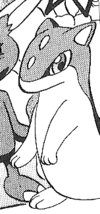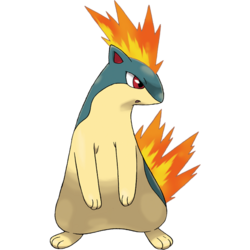From Bulbapedia, the community-driven Pokémon encyclopedia.
Quilava (Japanese: マグマラシ Magmarashi) is a Fire-type Pokémon.
It evolves from Cyndaquil starting at level 14 and evolves into Typhlosion starting at level 36.
Biology
Quilava is a slim quadruped Pokémon. The top half of Quilava's body is blue, while the lower half is cream. Its ears are triangular with red insides, and it possesses a rounded nose and red eyes. It has five red spots on its body that can project flames: two in a somewhat exclamation-mark shape on its forehead and three lined up horizontally on its rear. The fire coming from its head and rear can be launched as a flame attack. It also uses gusts of superheated air as a battle technique. Quilava's fur is non-flammable, so it can withstand flame attacks. Quilava tends to be rare in the wild, but can sometimes be found living on grasslands.
In the anime
Major appearances
Ash's Cyndaquil evolved into Quilava in An Old Family Blend!, fighting one of Team Rocket's mechas.
Dawn's Cyndaquil evolved into Quilava in SS024 in order to fight off a swarm of Ariados.
Other
Quilava first played a major role in Love, Pokémon Style! as Macy's Pokémon. She used it against Ash during the Silver Conference but was defeated by his Squirtle. Later in Tie One On!, she used it in her battle against Jackson, where it battled his Poliwhirl and won.
In Shocks and Bonds, Clark, a Trainer that likes to conduct battles like a symphony, used a Quilava and Charizard against Ash's Grovyle and Glalie. Despite the type disadvantage, Ash's Grovyle defeated Clark's Quilava.
A Quilava was used by one of two twin brothers in The Champ Twins! in a battle against Ash and Dawn. The other twin used Croconaw.
Minor appearances
Quilava first appeared as a cameo in the episode You're A Star, Larvitar where Ash witnessed a Trainer training with his Quilava for the Silver Conference and also considered for a short time of getting his Cyndaquil to evolve as a way of training it for the Silver Conference following Cyndaquil's defeat against Satchel's Magby.
A Quilava appeared in Deceit and Assist under the ownership of a Pokémon Coordinator during the Hoenn Grand Festival.
A Quilava appeared in Not on MY Watch Ya Don't!.
Pokédex entries
| Episode
|
Pokémon
|
Source
|
Entry
|
| EP262
|
Quilava
|
Ash's Pokédex
|
Quilava, the Volcano Pokémon. Quilava is the evolved form of Cyndaquil and capable of incredible attacks using the flame on its back.
|
|
| Episode
|
Pokémon
|
Source
|
Entry
|
| DP029
|
Quilava
|
Ash's Pokédex
|
Quilava, the Volcano Pokémon, and the evolved form of Cyndaquil. Its body is covered with fire-proof fur and can withstand any Fire-type attack.
|
| DP182
|
Quilava
|
Ash's Pokédex
|
Quilava, the Volcano Pokémon, and the evolved form of Cyndaquil. Quilava intimidates foes with its flame's heat, and when ready to battle, the fire burns with more strength.
|
|
| Episode
|
Pokémon
|
Source
|
Entry
|
| SS024
|
Quilava
|
Dawn's Pokédex
|
Quilava, the Volcano Pokémon. Quilava intimidates foes with its flame's heat, and when ready to battle, the fire burns with more strength.
|
|
In the manga

Quilava in Pokémon Gold and Silver: The Golden Boys
In the Pokémon Adventures manga
- Main article: Exbo
Gold's Cyndaquil of the Gold, Silver & Crystal arc in Pokémon Adventures evolved into Quilava during a training session at the Day Care Center outside of Goldenrod City. It then became massively more powerful than it was in its previous form, and defeated many of the Johto Team Rocket Grunts' Pokémon for Gold. After being used in Gold's battle with his rival Silver in the ruins of Ecruteak City, it spent several weeks captive inside one of Gold's Poké Balls and evolved simultaneously with Silver's Croconaw and Megaree. In its fully evolved form, it berthed itself even more in battle for the boy.
In the Pokémon Gold and Silver: The Golden Boys manga
Black borrowed a Quilava in a tournament in Let's Use Fighting Type Pokémon!!.
In the TCG
- Main article: Quilava (TCG)
Game data
Pokédex entries
| This Pokémon was unavailable prior to Generation II.
|
|
|
| Generation II
|
|
| Gold
|
Be careful if it turns its back during battle. It means that it will attack with the fire on its back.
|
| Silver
|
This Pokémon is fully covered by nonflammable fur. It can withstand any kind of fire attack.
|
| Crystal
|
Before battle, it turns its back on its opponent to demonstrate how ferociously its fire blazes.
|
| Stadium 2
|
Be careful if it turns its back during battle. It means that it will attack with the fire on its back.
|
|
|
| Generation III
|
|
| Ruby
|
Quilava keeps its foes at bay with the intensity of its flames and gusts of superheated air. This Pokémon applies its outstanding nimbleness to dodge attacks even while scorching the foes with flames.
|
| Sapphire
|
{{{sapphiredex}}}
|
| Emerald
|
It intimidates foes with intense gusts of flames and superheated air. Its quick nimbleness lets it dodge attacks even while scorching an enemy.
|
| FireRed
|
This Pokémon is fully covered by nonflammable fur. It can withstand any kind of fire attack.
|
| LeafGreen
|
Be careful if it turns its back during battle. It means that it will attack with the fire on its back.
|
|
|
| Generation IV
|
|
| Diamond
|
It intimidates foes with the heat of its flames. The fire burns more strongly when it readies to fight.
|
| Pearl
|
{{{pearldex}}}
|
| Platinum
|
{{{platinumdex}}}
|
| HeartGold
|
Be careful if it turns its back during battle. It means that it will attack with the fire on its back.
|
| SoulSilver
|
This Pokémon is fully covered by nonflammable fur. It can withstand any kind of fire attack.
|
|
|
| Generation V
|
|
| Black
|
It intimidates foes with the heat of its flames. The fire burns more strongly when it readies to fight.
|
| White
|
{{{whitedex}}}
|
| Black 2
|
It intimidates foes with the heat of its flames. The fire burns more strongly when it readies to fight.
|
| White 2
|
{{{white2dex}}}
|
|
|
| Generation VI
|
|
| X
|
Before battle, it turns its back on its opponent to demonstrate how ferociously its fire blazes.
|
| Y
|
Be careful if it turns its back during battle. It means that it will attack with the fire on its back.
|
|
|
Game locations
| This Pokémon was unavailable prior to Generation II.
|
|
|
|
|
|
|
|
|
|
|
In side games
Held items
Stats
Base stats
| Stat
|
Range
|
| At Lv. 50
|
At Lv. 100
|
58
|
|
118 - 165
|
226 - 320
|
64
|
|
62 - 127
|
119 - 249
|
58
|
|
56 - 121
|
108 - 236
|
80
|
|
76 - 145
|
148 - 284
|
65
|
|
63 - 128
|
121 - 251
|
80
|
|
76 - 145
|
148 - 284
|
Total: 405
|
Other Pokémon with this total
|
- Minimum stats are calculated with 0 EVs, IVs of 0, and (if applicable) a hindering nature.
- Maximum stats are calculated with 252 EVs, IVs of 31, and (if applicable) a helpful nature.
|
Pokéathlon stats
Type effectiveness
| Under normal battle conditions in Generation IX, this Pokémon is:
|
|
|
|
|
|
|
|
|
|
|
|
|
Learnset
|
|
|
|
- Bold indicates a move that gets STAB when used by Quilava
- Italic indicates a move that gets STAB only when used by an Evolution of Quilava
- Click on the generation numbers at the top to see level-up moves from other generations
|
|
|
|
|
- Bold indicates a move that gets STAB when used by Quilava
- Italic indicates a move that gets STAB only when used by an Evolution of Quilava
- Click on the generation numbers at the top to see TM moves from other generations
|
|
|
|
|
- Moves marked with an asterisk (*) must be chain bred onto Quilava in Generation VI
- Moves marked with a double dagger (‡) can only be bred from a Pokémon who learned the move in an earlier generation.
- Moves marked with a superscript game abbreviation can only be bred onto Quilava in that game.
- Bold indicates a move that gets STAB when used by Quilava
- Italic indicates a move that gets STAB only when used by an Evolution of Quilava
- Click on the generation numbers at the top to see Egg moves from other generations
|
|
|
|
|
- A black or white abbreviation in a colored box indicates that Quilava can be tutored the move in that game
- A colored abbreviation in a white box indicates that Quilava cannot be tutored the move in that game
- Bold indicates a move that gets STAB when used by Quilava
- Italic indicates a move that gets STAB only when used by an Evolution of Quilava
- Click on the generation numbers at the top to see Move Tutor moves from other generations
|
|
|
| Stage |
Move |
Type |
Cat. |
Pwr. |
Acc. |
PP
|
| This Pokémon has no moves exclusive to prior Evolutions.
|
- Bold indicates a move that gets STAB when used by Quilava
- Italic indicates a move that gets STAB only when used by an Evolution of Quilava
- Click on the generation numbers at the top to see moves from other generations
|
TCG-only moves
Side game data
Evolution
Sprites
Trivia
- Quilava shares its species name with Typhlosion and Entei. They are all known as the Volcano Pokémon.
- Quilava's Silver Pokedex entry states that it can withstand any type of Fire attack. However, it still took damage from Fire-type moves. This statement was made true in Gen 5, with Quilava recieving Flash Fire as a Hidden Ability.
Origin
Its appearance is similar to most animals in the weasel family, resembling stoats in particular based on its lack of a tail and the fur on its upper body being significantly darker than that on its underbelly. Its appearance is also quite close to a paca, a South American rodent with a slender body, spotted skin and tiny ears.
Name origin
Quilava is a combination of quill (a needle-like hair) and lava (extrusive molten rock).
Magmarashi is a combination of magma and 山荒 yama-arashi (porcupine).
In other languages
Related articles
External links

|
This Pokémon article is part of Project Pokédex, a Bulbapedia project that aims to write comprehensive articles on each Pokémon species, as well as Pokémon groups and forms.
|

































































































































































